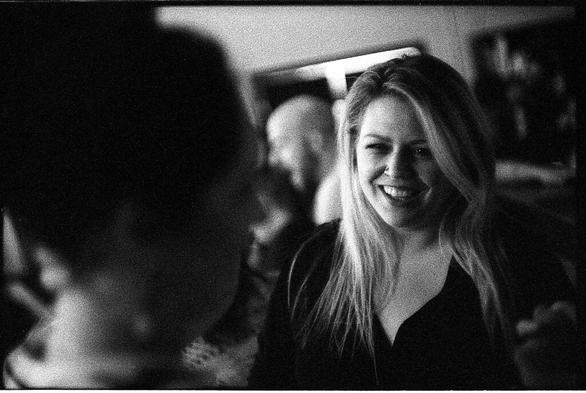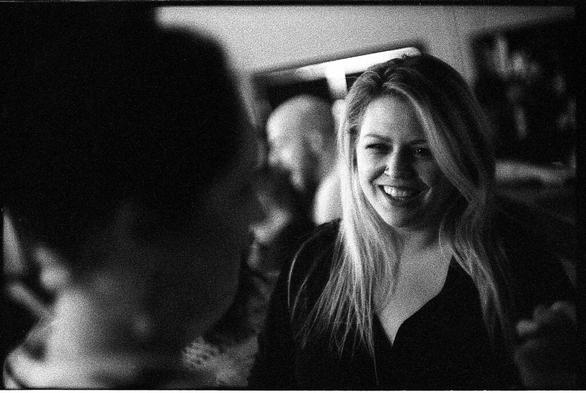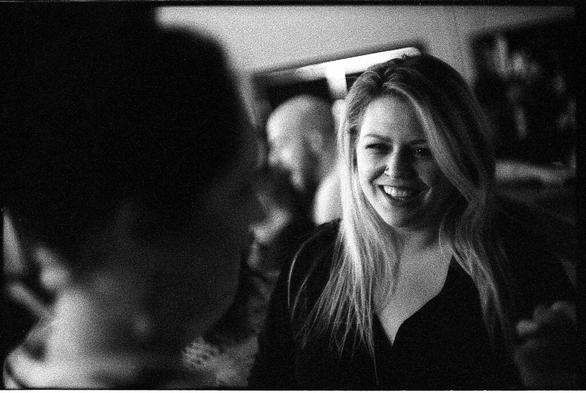Rating + Processing for Available Light Portraits – EI 3200 ISO
It bears repeating:
International Center of Photography shooter James Mignogna once told me that a good photographer matches their light, lens, film and developer. Nowhere do I think these decisions are more critical than portraits in dim lighting.
That was the intro I used in my previous entry: Rating + Processing for Available Light Portraits - EL 1600 ISO and it's as relevant to the entry you're reading now, which will center around 3200 ISO films. Of which, there are only two currently available.
SHOOTING IN THE DARK: KODAK TMAX P3200 AND DELTA 3200
Okay, so what happens when the sun goes down? 1600 and a 50/2 lens will not cut it anymore so you have to go faster. Ilford Delta and Kodak TMAX 3200 films are here to the rescue!
Armchair available light photographers delight in pointing out that Delta 3200 has a native ISO of 1000 and TMAX P3200 has a native ISO of 800. On a technical level, this is not misinformation. However, I am of the opinion that the constant restating of this as well as some incomplete, inaccurate tutorials about how to shoot these films has spawned not only an inaccurate belief that these films are "best" shot at their native ISO but even a bit of FEAR of shooting them at their box speed or higher.
I say, forget about this native ISO stuff!
For all intents and purposes, 3200 ISO is the NORMAL speed of Delta 3200 and TMAX P3200.
The DX codes printed on their canisters read 3200 by cameras and minilabs. Therefore, this is how Ilford and Kodak want these films to be rated and processed.
The films are not called Delta 1000 or TMAX P800, they're called 3200. This is not just marketing as people will lament on the interwebs.
These films are intended by their designers, to be rated at 3200 and processed for 3200. They are also designed to function as "multiple ISO films," as has been worded in older Kodak literature.
I don't personally see the point of paying for higher priced 3200 ISO films and, rating them well within the range of what 400 ISO film can handle, without a more specific reason than because a few influencers have told followers that this is how these films "should" be used.
To be clear, I'm not discouraging anyone from exploring what these flexible films can do, I'm denouncing boxing oneself into this native ISO rating.
If you are shooting a brighter scene but enjoy grain, yes, go ahead and under-rate your film. Rate it at 1600 and process normal (at EI 3200) This will give you richer contrast, you don't have to pay your lab extra money or separate or mark your film.
Jill| Kodak TMAX P3200 rated at 1600 ISO and processed normal at EI 3200
I was on a Nikkormat kick for some time and the meters on these and other classic cameras top out at 1600, so this guided how I shot and processed my 3200 films. In the example above, I was shooting in flat light that needed the under-rating to bring contrast to the scene. Some Nikkor lenses are not very contrasty at full aperture, so under-rating the film helps balance this out too.
If you like grain and tonality and shooting at wider apertures (a dreamy look, if you will), you can rate 3200 films at box speed to achieve this.
Laurie | Kodak TMAX P3200 rated at 3200 ISO and processed normal at EI 3200
In fact, you can always rate your film at 3200 and process normal at EI 3200. This is what Kodak and Ilford designed the film for and is it's "normal" look. No pushing, no pulling, no over- or under-rating. This will give you a flatter, more tonal image which is perhaps a less popular look currently and the reason that you see people recommending against EI 3200. But look, it's all about assessing the quality of the light you're working in and deciding what style you want. You may also just NEED that extra stop because the light is too dim to shoot at 1600 handheld.
I encourage other photographers not to assign subjective judgement such as presuming more contrast is "better" or less grain is "better."
In truth, everything's about balancing what you are working with and what you are trying to achieve. Under-rating (overexposing) your film may increase contrast but it also reduces tonality and shadow detail. It also gives you fewer apertures from which to choose. A detail-oriented shooter is going to be ready to shoot/process these films several ways depending on what the scene is giving them, as oppose to prescribing one method or film for every situation.
What I do most of the time is rate my film at 6400 ISO and process for EI 6400 by pushing one stop. This is critical of shooting in low light and night time without a flash or camera support and slow shutter speeds. It's how I shoot weddings and concerts and pre-pandemic bar hopping with friends. My reasoning is multi-fold. One being that the light meters of my best cameras top out at 6400, so I can operate them without a shred of guess work. Another being that I'm using these films to do what they were intended. The higher sensitivity allows me to stop down if there's ample light, so I can control my DoF more. The tonality I get from not under-rating gives me more "information" to work with when editing. And the final one being that I very seldom encounter a situation worth photographing where ISO 6400 with a 1/60th shutter speed and a 1.4 aperture are not adequate at bare minimum. Yes, these films can be rated even faster and you may use a lens faster than 1.4. But in these conditions, even with current digital cameras, one encounters some insurmountable (in my opinion) aesthetic concerns.
Christi | Kodak TMAX P3200 rated at 6400 ISO and push processed in Kodak HC110b by one stop for EI 6400
Laurie| Kodak TMAX P3200 rated at 6400 ISO and push processed in Kodak HC110b by one stop for EI 6400
Aside from how to expose and process, the other big question is which to use, Ilford Delta 3200 or Kodak TMAX P3200. In HC110b, I find the Kodak to be softer and more tonal, whereas the Ilford is sharper and more contrasty. So, just as I recommend under-rating or push processing to bring contrast to a scene with flatter lighting, I would also recommend choosing Delta. The opposite would be true for a contrasty scene, reach for the TMAX to quell that contrast. OR, if you want to emphasize a contrasty scene, use Delta and to emphasize a flat, dreamy scene, use TMAX. And within each model of film, you can rate and process to add or calm contrast.
Is your head exploding with options?
Don't worry! My recommendation is to start at box speed and normal processing and learn what works and doesn't work with your particular lenses and your usual scenes. I DO NOT recommend starting out by under-rating these films as many influencers will encourage. These films simply are not a one-size-fits all solution. They're not meant to be. They're SUPPOSED to be personally tailored. Just doing whatever you're told to do with them is negating the entire point.
Steph | Ilford Delta 3200 rated at 6400 ISO and push processed in Kodak HC110b by one stop for EI 6400
Lipstick Lamarr | Ilford Delta 3200 rated at 6400 ISO and push processed in Kodak HC110b by one stop for EI 6400
Devon | Ilford Delta 3200 rated at 6400 ISO and push processed in Kodak HC110b by one stop for EI 6400
Another important thing to keep in mind, which I've talked about but maybe not explicitly enough, is not to confuse quantity and quality of light.
Just because a scene has a lower QUANTITY of light and necessitates a higher ISO, this does not mean that you can ignore the QUALITY of the light just because you are shooting at 1600 or 6400. I see so many available light portraits at high ISO's with shadows on faces or other important elements of the scene. I think photographers forget this because in 100 and 400 ISO conditions which are often sunlit, one needn't pay a lot of attention to the quality of light in order to return acceptable photos. A shadow on a face may not turn into a grainy mess in the same way it does at 6400. In fact, I find that the less and less light you shoot in, I find that more critical the quality of that light becomes. And maybe this is one of the main reasons that shooting in these conditions is so challenging.
Tricia| Ilford Delta 3200 rated at 6400 ISO and push processed in Kodak HC110b by one stop for EI 6400
Notice in all these photos, both in this and the 1600 blog, regardless of how dark/black the surrounded area, highlights are generally on the faces. The inclination with candid portraits sometimes is to squeeze the shutter release during the peak of action. But with available light photography, not only must you consider the peak of action but also, this moment has to agree with where the light falls on your subject.
So when working in EI 1600 and 3200; it sounds cheesy and maybe even obvious but… let the light be your guide!
Don't choose your film, rating and process because someone who takes great photos said something is "the best," or because you saw some photos at those specs that look good. Ask these photogs about the quality of light they were shooting in and assess the quality of light you're shooting in. Consider the character of your lenses. Make judgement calls based on those points and your desired outcome. Film responds different ways in different situations. That's why digital can never fully copy it. And it's also why there's a lot to learn in order to get the look you're after. It's very possible that of all my examples, you still don't see something that's right for you. And that's okay. The concept is there. From 1600 to 6400 ISO/EI, hopefully I've given you a springboard from which to find combinations that work for what you are trying to do. Go out and find your own method for shooting portraits in low, available light!
Thanks for reading and happy shooting!
_Follow, Favorite, Like, Add, Insult, ContactJohnny Martyr _
#filmphotography #filmreview #ilford #kodak #martyrmusings #portraits #tipstricksadvice #1600 #1600iso #3200 #3200iso #6400 #6400iso #availablelight #availablelightportrait #barhopping #blackandwhite #blackandwhitefilm #blackandwhitehighspeedfilm #blackandwhiteprocessing #boxspeed #candid #concerts #contrast #contrasty #delta #delta3200 #dim #documentary #dreamy #dxcode #ei1600 #ei3200 #ei6400 #existinglight #existinglightportrait #fastlens #flatter #girls #grain #grainy #handheldcamera #hc110 #hc110b #highiso #highisofilm #highspeedfilm #ilforddelta #ilforddelta3200 #kodakhc110 #kodakhc110b #kodaktmax #kodaktmax3200 #kodaktmaxp3200 #lessgrain #light #lowlight #lowlightfilm #moregrain #nativeiso #naturallight #naturallightportrait #noflash #normalprocessing #overrate #overexpose #p3200 #personal #portraiture #process #processing #pullprocess #pushprocess #qualityoflight #quantityoflight #rating #sharp #soft #tabulargrain #tmax #tonal #traditionalfilm #true #underrate #underexpose #weddings











